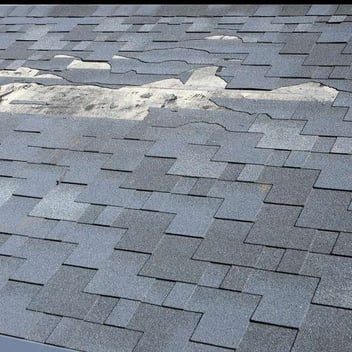- Home »
- Learningcenter »
- How to deal with roof storm damage
How To Deal With Roof Storm Damage in 2023? - A Step by Step Guide
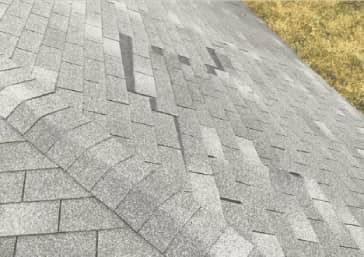
In Georgia, we experience the worst storms in the summer months when remnants of hurricanes pass through. This can result in significant roof storm damage.
However, we also tend to get significant rain into the winter and early spring months. We live in one of the most dense tree environments in the country, so our roofs are constantly dealing with debris falling and nature wearing away at them.
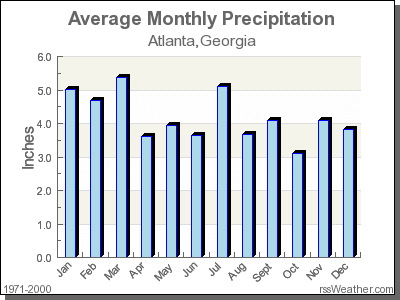
It’s very likely that you’ll experience storm damage to your roof over the years of owning a property. This guide helps you understand what to look for when diagnosing storm damage and what you can do to mitigate the damage.
Main Types Of Roof Storm Damage
Following the passing of a storm, you’ll want to do a full walk-around of your property to make sure you document all of the damage before time passes. This will give you the documentation needed down the road if you decide to hire a restoration contractor or file an insurance claim.
During your walk-around, you’ll want to make sure you look out for the following types of storm damage to your roof:
Wind Damage
In Georgia, wind damage is a fairly common occurrence. This is most common on three-tab shingles.
If your shingles look like the picture below, you most likely have three-tab shingles that are more susceptible to wind damage.
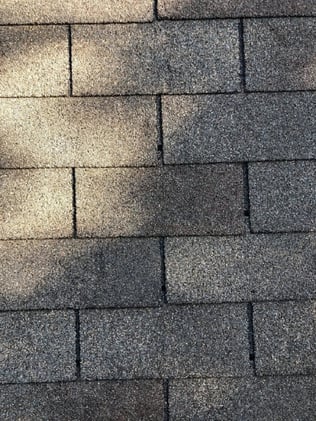
The biggest signs of wind damage to your roof are flipped shingles, creased shingles, and displaced shingles. Obviously, if you find shingles laying in the yard, that is a sign of damage. However, creasing can be far more difficult to spot from the ground, but is just as detrimental to the roof.
The picture below shows exactly what you’re looking for when you’re scouting out wind damage.
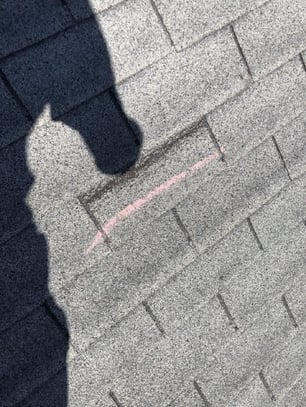
This shingle is close up and extremely creased, so it probably seems obvious that the shingle is damaged. However, from the ground it can be very hard to determine if your roof has wind damage. It’s likely best to have a roofing contractor do an inspection for you either via drone or on the roof.
Hail Damage
While not quite as common in Georgia, hail damage comes in waves. Various areas of metro Atlanta and the surrounding areas typically experience hail once or twice per year. Some of the more recent hail storms have happened in the Roswell and Cumming area.
Hail damage is going to be almost impossible to spot from the ground level due to the smaller size hail we experience in Georgia (1-2 inch typically). In the Midwest or Texas, hail can reach softball size, at which point it can create holes in a roof. However, we just don’t see that amount of damage in Georgia.
Despite the smaller size of hail storms in Georgia, it can still damage your roof and cause significant problems. Here is a picture of hail damage found on a roof in Atlanta:

You can see in this picture where the fibers of the shingle are actually exposed from the impact. This will result in fast deterioration in the shingle and eventual leaking inside.
Again, it is very difficult to spot this damage from the ground because of it can be mistaken for blistering in the shingles, which is caused by heat getting trapped in the asphalt. It is best to have a roofing contractor perform an aerial inspection of the roof to determine if it has sustained hail damage.
Tree And Debris Damage
Georgia is home to a plethora of trees and nature, which is great for us but not so great for our roofs.
Trees constantly drop debris, cast shade, and potentially even fall on our roofs. During your post-storm walk around inspection of your property, if you notice a significant amount of debris laying in the yard or surrounding the property, this is a sign of possible debris damage.

This is the most obvious type of roof damage that exists and generally requires urgent mitigation. If your property sustains tree damage, you should call a local roofing contractor that provides emergency tarp service To minimize the interior damage that may follow.
Other Signs Of Damage To Look For
There may also be signs inside the property that are signs of roof storm damage. Those signs include:
- Drywall cracking
- Water puddles on the ground (obviously!)
- Water stains on the ceiling
- Unusually hot or cool temperatures inside
- Mold or mildew stains
Again, it’s best to have a professional roofing contractor take a look and make sure there is nothing to be concerned about. The National Roofing Contractors Association recommends that homeowners get their roof inspected by a professional twice a year—once in the fall and once in the spring.
DO's And DON'Ts
DON'T Give In To Storm Chasers
This is possibly the most important point in this article. There are contractors all over the country that do nothing but chase storms in order to take advantage of the quick money that can be made from helping you file an insurance claim after a storm.
While not all are dishonest, storm chasers are typically not local companies with a long standing reputation. It is always best to stay away from doing business with door-knockers and storm chasers. Call on a trusted local roofing company to help you, so you know they are there if anything goes wrong with the roof down the road.
“Unfortunately, severe storms can bring out the worst in people, especially unscrupulous roofing contractors who scam consumers needing to repair or replace their storm-damaged roofs,” the Insurance Institute for Business and Home Safety said after a record-breaking hail storm in 2017. “These fraudsters will often make false promises, insist on full payment before work begins or is completed. Sometimes, they will even create damage where none existed.”
DO Call A Trusted Local Roofing Contractor
Do your research and make sure the company you are choosing is reputable and trusted by your fellow property owners.
Here's a great resource for finding one in Atlanta, GA...

Whether filing an insurance claim, paying out of pocket, or choosing a payment plan option, we’ll walk you through the various options you have and what we would recommend based on our experience with the various insurance carriers.
If you have recent storm damage to your roof, call us today for a free, no obligation inspection. We’ll work with you to come up with a plan forward to restore your property.
 Call (678) 365-3138
Call (678) 365-3138
